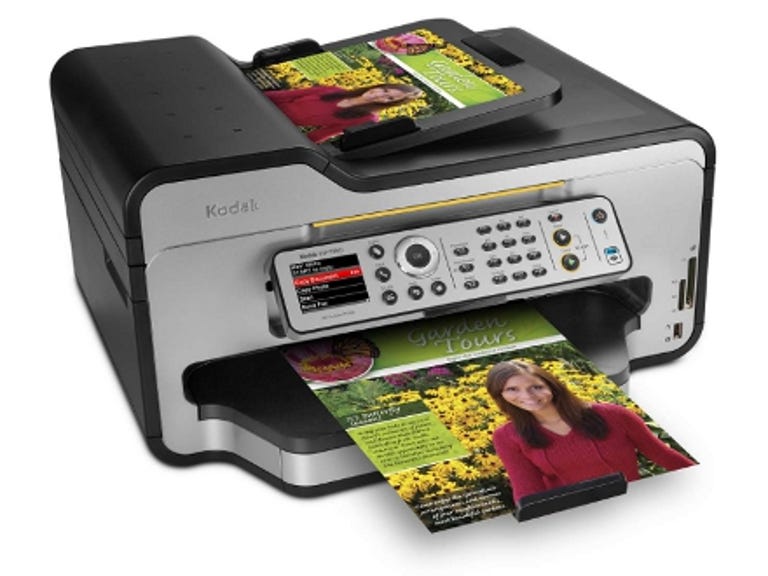 Why You Can Trust CNET
Why You Can Trust CNET Kodak ESP 9250 review: Kodak ESP 9250
The Kodak ESP 9250 is very cheap to run and produces decent results. If you're looking for a printer to use in a busy home office, we think it's a good-long term bet.
The Kodak ESP 9250 inkjet all-in-one printer is the big brother of the ESP 7250. It adds an automatic document feeder and fax support, so it's more suitable for use in a home office. As with most of Kodak's printers, it's more expensive initially than equivalent rival machines, costing around £180, but it's cheaper to run than most of the competition.
The Good
The Bad
The Bottom Line
Déjà vu design
Visually, the 9250 is very similar to the 7250. Essentially, it looks like a large box that has curved sides and a large mouth in the middle where the printed sheets are feed out onto a telescopic tray. Above the mouth sits the flip-out control panel that houses a 2.4-inch screen, along with dedicated buttons for the various printing, scanning, copying and faxing functions. There's also a numerical keypad for dialling fax numbers.
The front is home to two memory-card slots. The first takes care of xD, SD and Memory Stick cards, while the second accommodates CompactFlash cards. Beneath these, there's a PictBridge-compatible USB port that lets you use the printer to grab photos directly from compatible cameras or USB drives.
Kodak has added an automatic document feeder to the top of the flatbed scanner. It accepts documents of up to 30 sheets, and allows you to automatically copy or fax multi-page documents, without having to manually place each sheet on the scanner's glass surface -- a great time-saver when you're using the 9250 in a home office.
The main paper tray at the bottom holds up to 100 sheets of paper, which isn't a huge amount for a home-office model. But it does also house a separate photo-paper section, so you don't have to remove the normal A4 sheets of paper when you want to print photos, as you do with some other models.

The 9250 can be used over USB, Wi-Fi or Ethernet. The latter two options make it easy to share the printer with other computers on your network, and both are pretty straightforward to set up.
Installing the cartridges is also easy. There are just two cartridges, as Kodak combines all the colour inks into a single cartridge. That's not the best idea in our book, as, if you run down just one colour, you have to replace the whole cartridge. The two cartridges slot into a semi-permanent print head, which then slots into the main print mechanism. Once the 9250 has completed printing an alignment page and you've loaded the drivers on your computer, you're good to go.
Leisurely printing
The integrated scanner is reasonably quick to scan documents and photos, and the results are generally of a good quality. It's also fast when it comes to photocopying -- our black and white test page was completed in just 23 seconds. While copied text looks crisp, though, there's some banding visible in black areas of the page.
The 9250 supports automatic duplex printing so you can print on both sides of a sheet of paper without having to manually turn it over and feed it back into the printer. But, like the 7250, when printing in duplex mode, the overall print area is reduced. We couldn't find any solution to this annoying problem.
The 9250 is no speed demon when it comes to printing. Our ten-page black and white text document took a rather leisurely 3 minutes and 1 second to complete, while ten copies of our graphics test sheet were similarly slow to emerge, taking 3 minutes and 35 seconds. A ten-page presentation was slower still, at 4 minutes and 23 seconds. The photo-printing speed wasn't bad, however, at 51 seconds for a 4- by 6-inch print.
Photos look impressive, with little of the stippling that affects the results of some lesser printers. But, although text doesn't exactly look bad, it's not as clean as it could be. There's also some banding visible in colour fills in graphics.
Kodak has managed to keep printing costs to a minimum. At current cartridge prices, a black and white page works out at a very reasonable 2.3p, while a colour page is also cheap, at 4.5p. Both these prices include 0.7p for paper costs.
Conclusion
If you're willing to sacrifice some speed and print quality for cheaper running costs, the Kodak ESP 9250 is likely to prove a worthy long-term printing partner.
Edited by Charles Kloet


